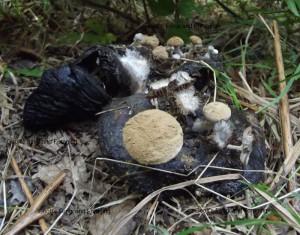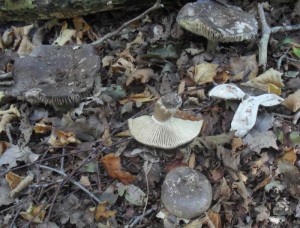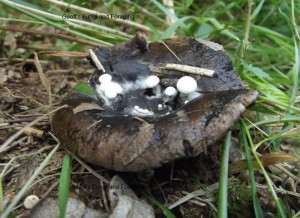30/08/2013
There is no shortage of oddities in the world of fungi. I’m yet to find the powdercap strangler (Squamanita paradoxa), which takes over the fruiting body of another fungus (Cystoderma amianthinum) and replaces its cap with its own – resulting in the fungal equivalent of something like a dog with a cat’s head, or the horn stalkball, which only grows on old sheep/goat horns. I came across something yesterday that comes close though, and similarly demonstrates just how specialised some species of fungus are in terms of their chosen habitat. The fungus in the picture to the right is a very common mushroom called a blackening russula (R. nigricans). This species is edible, if not choice, provided you find it when it is still grey (more often you will just find its blackened remains, which persist throughout the winter). It is a bit indigestible, but pleasantly nutty and perfectly acceptable to eat after frying well in butter.
However, not only humans eat these. Most of them will be left to peacefully decay, but every now and then a set of small white blobs will emerge from the blackening cap. These are mushrooms growing on a mushroom. This is the sole habitat of the powdery piggyback – it grows nowhere else other than the decaying fruitbodies of Russula nigricans. It is a bit unusual (for me at least) to see them this early in the season.

Powdery piggybacks (Asterophora lycoperdoides) on Russula nigricans fruit bodies in advanced state of decay. Late August 2013.
As they reach maturity, it becomes obvious they are mini-mushrooms. They are members of the family Lyophyllaceae – cousins of edible species such as the clustered domecap or fried chicken mushroom (Lyophyllum decastes) and St George’s Mushroom (Calocybe gambosa). I have been asked if they are edible. I guess they might well be, but they are so small and uncommon that it is hard to justify eating them, and they don’t exactly look very appealing.
They have a close relative – very similar looking, but not powdery, and adapted to precisely the same way of life. These are called silky piggybacks (Asterophora parasitica).
Mushroom season 2013 is still ramping up nicely. I found a perfect penny bun yesterday, some suillus boletes, a tawny grisette and loads more russulas. Perhaps more importantly for me, as somebody who is currently hunting for photos, nearly all of what I am finding is in very good condition. This could not be more different to last year, when everything was being massacred by slugs.


